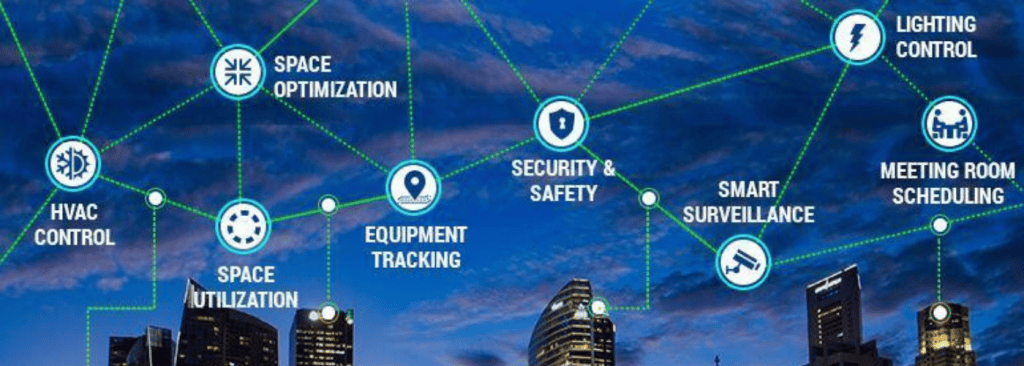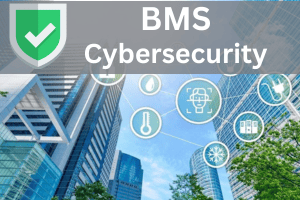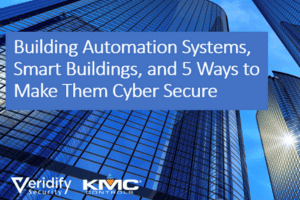Smart Building Cybersecurity Best Practices
The true power of smart buildings lies in their ability to adapt and respond intelligently to the needs of occupants, enhancing comfort, efficiency, and sustainability.
Understanding Smart Buildings
Smart Buildings are structures equipped with a network of interconnected devices, sensors, and systems that collect and exchange data to optimize various aspects of building operations including operational efficiency, sustainability, occupant comfort and experience. These connected components include heating, ventilation, and air conditioning (HVAC) systems, lighting, access control, elevators, life safety, and more. The integration of these systems allows for centralized control and automation, contributing to energy efficiency, cost savings, and improved occupant comfort. Smart Buildings epitomize the synergy between the digital and physical realms.
Smart buildings also collect valuable data from user devices, sensors, infrastructure components, and automation and control systems in the building. Analyzing and applying that data using artificial intelligence and machine learning (AI/ML) algorithms makes the building more responsive to the needs of the users, building manager, and building owner.
Smart buildings use data and analytics to optimize energy use, reduce operational costs, and create a more sustainable built environment.
Key benefits of smart buildings include:
- Lower operational and energy costs
- Improved occupant comfort
- Greater flexibility
Smart Building Cybersecurity Challenges
The basic communication protocols used for building controls (e.g. BACnet) are inherently unsecure. As the capabilities of Smart Buildings expand, so do the challenges of securing them. Since Smart Buildings rely on a network of devices communicating with each other, and connectivity to cloud-based services through the Internet, vulnerabilities can be exploited by malicious actors. Common risks include unauthorized access to building systems, manipulation of environmental controls, and potential breaches of sensitive data collected by sensors. The shift towards remote access and cloud-based solutions further amplifies the attack surface, necessitating robust security measures to protect against cyber threats.
Smart building cybersecurity is not just a feature but a fundamental requirement to protect critical infrastructure, operations, and occupants.
Best Practices for Smart Building Cybersecurity
- Network Segmentation: Divide the smart building network into isolated segments to limit lateral movement in case of a security breach. This reduces the impact of a potential compromise and enhances overall network security.
- Authentication: Implement robust identity verification mechanisms for users, devices, and data. Multi-factor authentication, biometric authentication, and strict access controls based on roles are integral to the Zero Trust approach.
- Continuous Monitoring: Deploy real-time monitoring systems to detect anomalies and potential security incidents. Automated alerts and responses ensure that any deviation from normal behavior is addressed promptly.
- Encryption: Secure data in transit and at rest through the use of strong encryption protocols. This safeguards sensitive information exchanged between devices and systems within the smart building ecosystem.
- System Updates:Maintain up-to-date software and hardware to ensure that building systems are running on the latest, most secure versions.
- Incident Response Planning: Develop comprehensive incident response plans tailored to the unique challenges of smart buildings. These plans should outline clear procedures for addressing security incidents, minimizing the potential impact on building operations.
- User Education and Awareness: Foster a culture of cybersecurity awareness among building occupants and personnel. Educate users about potential risks, the importance of adhering to security protocols, and their role in maintaining a secure Smart Building environment.
- Regular Security Audits and Assessments: Conduct regular security audits and assessments to identify vulnerabilities and areas for improvement. Regular testing ensures that security measures remain effective against evolving cyber threats.
Zero Trust for Smart Building Cybersecurity
The National Institute of Standards and Technology (NIST) Zero Trust architecture has gained prominence as a robust approach to cybersecurity. Originally applied to IT networks, NIST Zero Trust principles are increasingly relevant for smart building cybersecurity and securing building controls. The fundamental tenet of Zero Trust is the elimination of implicit trust in any entity, whether inside or outside the network. Every user and device, even those within the network perimeter, must be continuously verified before being granted access to a resource.
Applying Zero Trust to building controls involves rethinking traditional security models. Instead of relying on a presumed secure internal network, access controls are implemented based on the principle of least privilege. Users and devices are only granted access to the specific resources necessary for their roles, reducing the risk of lateral movement in case of a security breach. For the device-to-device communication in building networks, this means that each device must be authenticated in order to communicate with another device.
Continuous monitoring is a cornerstone of Zero Trust. In the context of Smart Buildings, this means real-time scrutiny of devices, sensors, and users. Any unauthenticated communication attempts will be blocked in real-time and will trigger an alert. The security of the building controls is not compromised while waiting for an investigation to begin. This is a proactive approach to security embodied in DOME that aligns with the real-time operations of Smart Buildings.
Zero trust is not just a proactive security model for smart buildings, it is the future of cybersecurity and requires a mindset shift that requires continuous verification and validation of every device, user, and application accessing the network, that aligns with the dynamic nature of modern digital infrastructure.
Conclusion
As smart buildings continue to shape the future of architecture and urban living, securing these dynamic environments becomes paramount. Embracing the NIST Zero Trust framework for building controls provides a comprehensive and adaptive approach to cybersecurity. By implementing best practices, continuous monitoring, and user education, facility managers can navigate the complexities of securing smart buildings, ensuring a future where innovation and security coexist in the built environment.
—
Blog Post Summary – All of our posts listed on one page back through 2019
See the slides below to learn more about cybersecurity for building controls and smart buildings.
Keywords: Smart Building Cybersecurity







